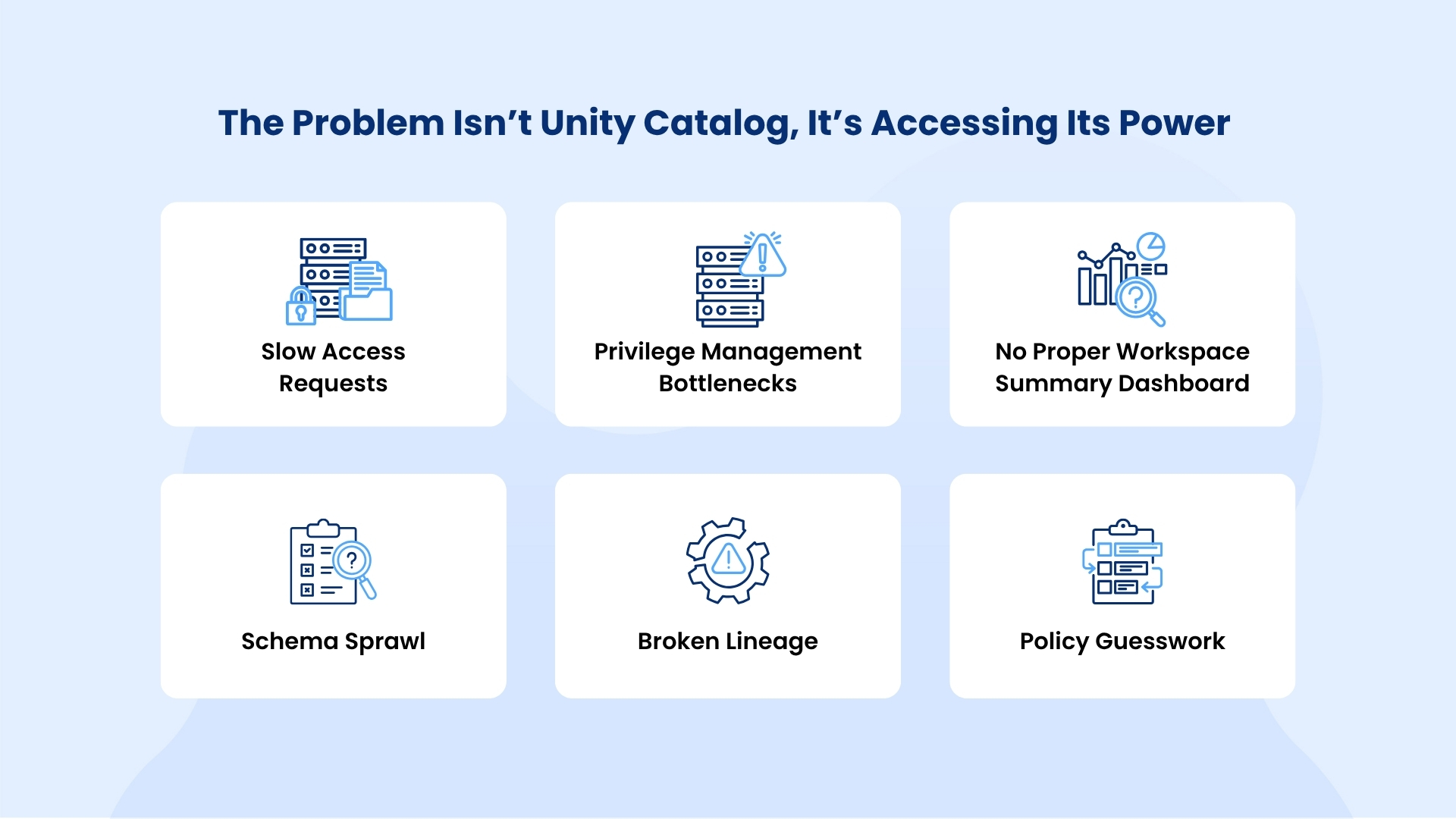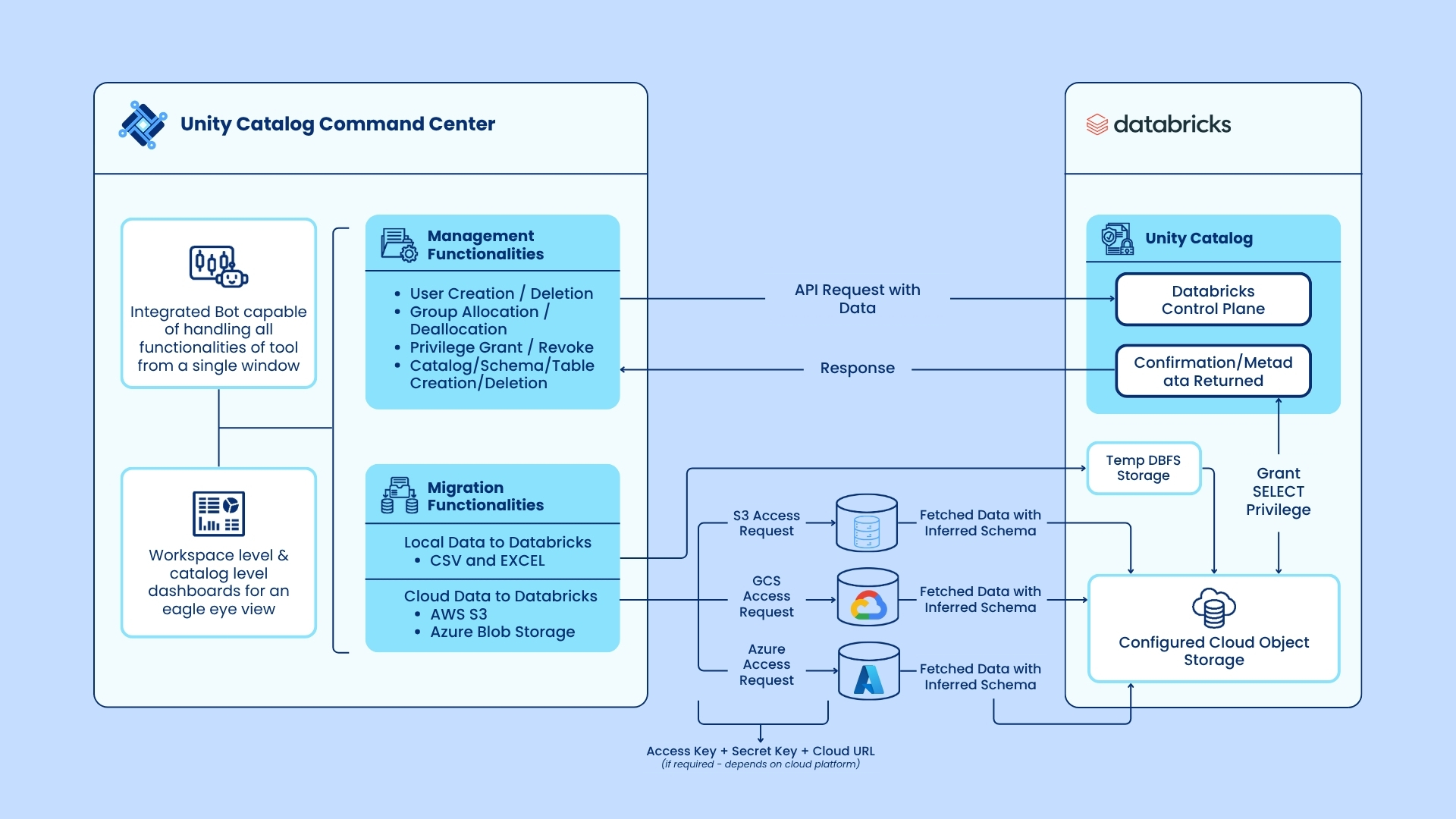The author is a Associate Data Engineer in Eucloid. For any queries, reach out to us at: contact@eucloid.com
Introducing Unity Command Center: Databricks Governance, Without the Guesswork

Modern data teams don’t just need compliance.
They need clarity. Speed. And the power to act.
In the modern enterprise, data governance is no longer a backend concern, it’s a business-critical function. As data volumes explode and teams across the organization rely on analytics for decision-making, the pressure to ensure secure, consistent, and scalable data access has never been higher.
Unity Catalog, Databricks’ unified governance layer, has been developed to answer those very needs. It introduces a powerful framework for managing access, enforcing policies, and tracking lineage across the Lakehouse. It centralizes permissions and even tracks lineage. For data engineers and platform teams, it’s a way to bring structure to sprawling data estates.
Eucloid’s in-house UC Command Center comes into the picture. With intuitive workflows, business friendly interfaces and multiple user-friendly features, the UC command center makes Data Governance accessible to the wider team of analysts, product managers and business stakeholders. Our UC command center takes the best parts of Unity Catalog and makes data governance a truly enterprise-wide play.

The Problem Isn’t Unity Catalog, It’s Accessing Its Power
Unity Catalog lays the right foundation for modern data governance. But the experience of using it day-to-day can be limited to technical users. That leads to:

-
Slow Access Requests: Non-technical teams have to wait on engineers for a simple role or table access.
-
Privilege Management Bottlenecks: Granting the right permissions, especially across nested schemas and dynamic user groups, often requires manual effort and deep familiarity with Unity Catalog’s security model.
-
Schema Sprawl: As projects grow, so do the number of schemas, leading to naming conflicts, unused assets, and unclear ownership.
-
Broken Lineage: Identifying the root cause of data issues means manually tracing pipelines and dashboards.
-
Need for a Workspace Summary Dashboard: A built-in, easy-to-read summary that shows at a glance how the workspace is organized without manual effort.
UC Command Center: A Visual Layer on Top of Unity Catalog, Built on Databricks
Eucloid’s UC Command Center is a plug-and-play UI accelerator that makes Unity Catalog usable for everyone, not just engineers.

Here’s how it transforms the governance experience:
1. Real-Time Governance Dashboard
Problem: Admins lose hours manually compiling reports to track catalogs, schemas, and user activity - spread across tools and tabs.
Solution: A unified dashboard with real-time insights on:
- Catalog and schema counts
- Table-level activity
- Storage utilization
- Active users with drill-down capabilities

Impact: Audit prep drops from days to minutes. Idle datasets and unused roles are flagged early, enabling cost and resource optimization.
2. AI-Powered Chatbot Assistant
Problem: Managing Unity Catalog via CLI or SQL is time-consuming, and excludes non-technical users.
Solution: An NLP-driven chatbot that supports:
- Natural language and voice queries
- Self-service user provisioning
- Automated access control and catalog management
.png)
Impact: Business teams cut task times by 90% with self-service of day-to-day tasks.
3. Bulk Grant/Revoke Access Controls
Problem: Granting or revoking privileges across catalogs, schemas, or tables requires manual updates for each user/group, often leading to inconsistent access.
Solution: A visual permission management tool with:
- Bulk selection of users, groups, and assets
- One-click assign/revoke actions
- Role-based templates and audit trails
Impact: What took minutes now takes second,and access control remains consistent.
4. One-Click Data Migration & Governance
Problem: Migration from CSVs or cloud storage requires multiple steps: upload, manual schema definition, table creation, separate access setup, often done manually.
Solution: Streamlined ingestion from S3/GCS/Azure with:
- Auto-schema detection
- Governed table creation
- Built-in access policies
.png)
Impact: Seamless migration, immediate compliance, and no gaps between ingestion and governance.
5. Unified User Management
Problem: Setting up users and roles involves navigating multiple Databricks tabs, increasing onboarding time and human error.
Solution: A single GUI to:
- Create/delete users
- Assign roles and access levels
- Apply provisioning templates and bulk edits
.png)
Impact: New user setup becomes fast, 100% compliant, and standardized across teams.
6. Catalog & Schema Visualization
Problem: Unity Catalog’s native view is technical and scattered, making it hard to navigate catalogs and schemas intuitively.
Solution: An experience designed the way teams work:
- Intuitive view: Catalog → Schema → Table
- Instant summary cards with key metrics
.png)
Impact: Faster audits. Quicker spotting of outdated tables during migrations.

Built for Databricks. Made for Everyone.
UC Command Center amplifies the impact of Unity Catalog across the organization.
It’s a layer built natively for Databricks users, with no custom integration or migration required. Whether you’re a data engineer cleaning up governance debt or a business analyst trying to understand data access, this tool meets you where you are.
And because it works across workspaces and clouds, it's enterprise-ready from Day 1.
Get in touch at databricks@eucloid.com to explore how we can support your next move.
Posted on : June 02, 2025
Category : Data Engineering
About the Authors


The author is a Associate Data Engineer in Eucloid. For any queries, reach out to us at: contact@eucloid.com